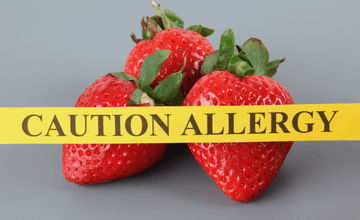Blog
Strawberry Allergies Explained
by
Kate Young
on
Feb 05, 2022
Strawberries are a loved delight in the UK. But biting into these little bundles of sweetness can lead to adverse effects if you have a strawberry allergy. It might come as a shock to many that strawberry allergies exist, but they do. Strawberry allergy, even though uncommon, still affects a good number of people, which is quite unfortunate. The allergy prevents you from consuming the fruit and similar fruits.
What is a strawberry allergy?
A strawberry allergy can range from mild to severe. By severe, we mean an anaphylaxis attack which requires medical emergency assistance and can be highly life-threatening. A strawberry allergy occurs when one eats a strawberry, and within minutes the body starts showing these symptoms, indicating it doesn't like it.
Suppose you have a strawberry allergy the moment you consume strawberries. In that case, your immune system assumes they are dangerous, like a virus or bacteria leading to the production of histamines resulting in symptoms of an allergy and sometimes even leading to anaphylaxis which needs you to contact emergency services like 911.
What causes strawberry allergy?
The causes of strawberry allergy aren't defined, but some research shows that it is due to the body's reaction to the proteins found in strawberries. There is a protein known as Fragaria allergen 1 (Fra a 1), which helps aid in the ripening of red strawberries that are linked to causing a strawberry allergy. This protein is also notorious for causing oral allergy syndrome symptoms.
The good news is if you're allergic to specifically Fra a 1, you can always consume other strawberry varieties like white or yellow strawberries. The lack of enzymes causes strawberry intolerance to process the proteins found in the food you've consumed. Alternatively, strawberry allergy results from your immune system mistaking the components of the food you've eaten as "harmful", thus releasing an insane amount of histamine. Sometimes a strawberry allergy can be so severe that it causes allergy symptoms upon coming in contact with strawberries.
Strawberry allergy symptoms
- Itchiness and skin inflammation in the mouth and throat
- Skin rashes like hives and eczema
- Cough, congestion, wheezing
- Dizziness and lightheadedness
- A feeling of tightness in the throat
On rare occasions, a strawberry allergy can lead to a severe reaction called anaphylaxis{1}. Symptoms of anaphylaxis include;
- Rapid pulse
- Tongue swelling
- Swelling in the throat leads to blocked airways
- Severe drop in blood pressure
- Lightheadedness and dizziness
- Fainting or loss of consciousness
People who experience severe reactions to strawberries should carry an EpiPen with them at all times as it helps counteract the effects of an allergic reaction.
Since toddlers can't communicate or navigate how they are feeling, you can tell your baby has a strawberry allergy through the symptoms they're displaying. Strawberry allergy in toddlers can be seen through symptoms like; pale skin, vomiting, diarrhoea, loss of consciousness, hives, itchy skin rashes, and swelling. It would be best to visit a paediatrician to ensure they take tests and rule out any other underlying conditions that could cause these symptoms.
Another common strawberry reaction is oral allergy syndrome (OAS). OAS mostly develops in people who are already suffering from hay fever. It is brought on by consuming fresh vegetables and fruits. Its symptoms include scratchy moth, itchy throat, and swelling in the mouth, around the mouth, and throat. Most of the time, this reaction disappears when one swallows or removes the strawberries from the mouth. Some people can eat the vegetables and fruits when cooked, while others have a severe reaction that needs emergency treatment.
Testing for strawberry allergy

Our Allergy Test Box Kit
A simple IgE test can help you determine whether you have a strawberry allergy or not. Nowadays, allergy tests are available online. You order yourself a
Strawberry Allergy Test, and it will be delivered to your mail within three days. Upon collecting your sample and sending it back to the lab, you will receive your test results within three days. This allergy test checks for strawberry allergy and other 34 common allergies. It checks for allergens in drinks, other foods, and the environment.
If you have a strawberry allergy, the test will show it and will advise you on which other fruits you should avoid that contain the proteins in strawberries that are causing the allergy symptoms.
How to treat a strawberry allergy
Even though an allergy test only helps you know which allergies you have, it doesn't offer treatment but guides on what to avoid. If you have a strawberry allergy, you will need to avoid anything with strawberries like; fresh and dried strawberry, candy and jelly strawberry, and jams that contain strawberries.
Strawberries belong to the
Rosaceae family. This means that there are other fruits in this family that you could be allergic to like;
- Raspberries
- Cherries
- Peaches
- Apples
- Blackberries
If you are allergic to any
Rosaceae family fruits, you may also be allergic to strawberries. Some research shows that you can consume white or yellow strawberries as they don't contain the same proteins found in the red type{2}. You can also eat bananas or melons, yummy alternatives to strawberries.
When grocery shopping, always read carefully through the ingredients to ensure no strawberries. If you deal with strawberry allergy and experience mild reactions, you can take over-the-counter antihistamines. Antihistamines help prevent the body from overreacting and will help reduce the severity of the symptoms. But if you have severe reactions or your first time getting a strawberry allergy, it is best to visit your doctor.
What are the risk factors of strawberry allergy?
Some people have a higher risk of getting a strawberry allergy. You're at a higher risk if you have;
- Eczema
- Asthma
- A family history of allergies
It is possible to develop allergies at a later age. But most of the time, children are at a higher risk of developing allergies, even though some outgrow these allergies. It is possible to develop strawberry allergies even if you have no family history of allergies. When weaning your baby, ensure you introduce allergen foods before 7.5 months. Introducing them afterwards could increase their risk of developing an allergy. If your baby develops symptoms of strawberry allergies, eliminate the fruits and other foods containing them from their diet.
Strawberry allergy overview
Even though strawberries are yummy fruits, you can always enjoy others that aren't in the
Rosaceae family. If you are keen on ingredients, especially flavourings, you can steer clear of strawberry allergy symptoms. Always let your server know about your allergy when eating out, and when visiting, let your host know about it too, and you will be safe. If you ever want to reintroduce strawberries back to your diet, you will need to consult your doctor, and you will both see if that's possible or not.
In case strawberry isn't your only allergy and there are many fruits and vegetables you can't consume, you will need to consult your doctor and see if you'll need to supplement some vitamins and nutrients, so you don't end up deficient. If you have ruled out diseases you might think you have, and you now feel as if these strawberry allergy symptoms match what you're suffering from, you can order a
Strawberry Allergy Test kit and learn if you're truly allergic or not.
References
- Anaphylactic reactions to cherries, strawberries, and grapes. (2018, April 12)
https://www.aaaai.org/ask-the-expert/anaphylactic-reactions-cherries-strawberries
- Katie Cottingham. Journal of Proteome Research • Vol. 6, No. 8, 2007 https://pubs.acs.org/doi/pdf/10.1021/pr070772v
 Our Allergy Test Box Kit
Our Allergy Test Box Kit











